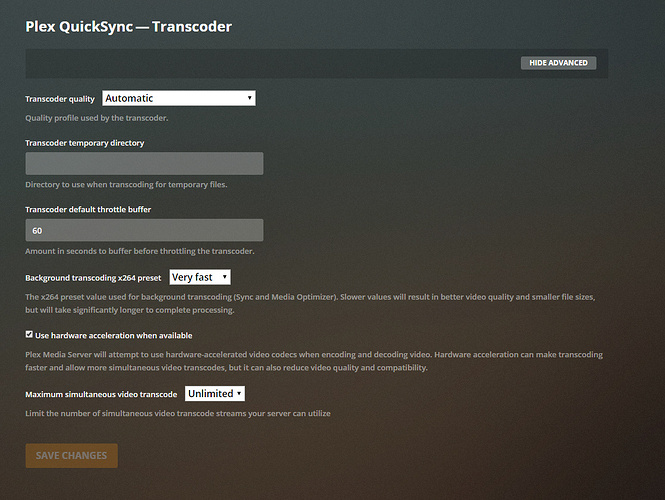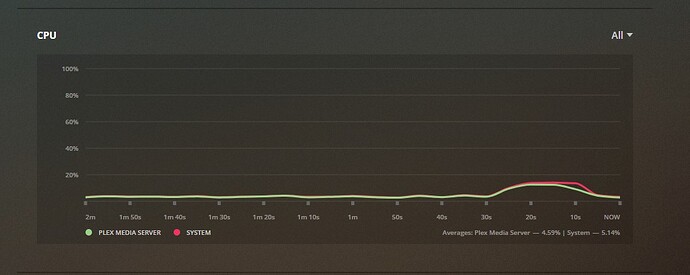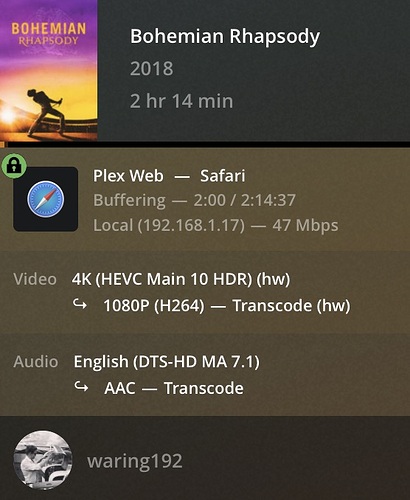ok , so how do I troubleshoot it?
Are you using linux like the guide recommends?
Are you running 19.10 by chance? @Hey_Danny is having similar issues.
Checking now
19.04 for me
Is this supposed to be server or desktop version?
I’m on 19.10 and it seems to be doing fine for me. I thought the cpu usage before my most recent update to 19.10 was more than it should be, but it was still only around 25-30%. But running ubuntu 19.10 and Plex Version 1.18.1.1973 seem to have improved it.
I think the main difference is the desktop environment. I’m using Ubuntu desktop.
Shouldn’t matter if it’s desktop or server.
Updated to reflect recommendation of using the Plex official package.
“Ubuntu (16.04+) / Debian (8+) - Intel/AMD 64-bit”
Added this screenshot above.
i3-8130u laptop with 8GB of RAM achieving 17 1080p 8Mbps transcodes. I was starting to run into client issues. No buffering or issues server-side.
After reading this… still not sure if it’d be more worth it to get a i7 7th gen or an i5 8th gen…
or even an i7-6700 6th gen versus an i5-7500 7th gen??
6th-gen is missing HEVC support, I’d recommend 7th or higher. I find that 8th-gen laptops are the most cost effective way.
I moved from a Win 2012R2 dual xeon plex server to a quicksync build and the difference is amazing.
Box:
Dell Inspiron 3670 Intel Core i7-8700 16GB 128GB NVMe running Ubuntu 19.04 with a HDMI Plug.
Before, with my windows box I was able to support maybe a max of 10-11 transcodes and my CPU would be pegged, now, its barely touched,
Sessions: 11 streams (4 direct plays, 7 transcodes) | Bandwidth: 42.2 Mbps (LAN: 5.3 Mbps, WAN: 37.0 Mbps)
I’ve created some all-encompassing searches for 7th-9th Generation quicksync processors, desktops, and laptops. These searches include every major CPU model from the particular generation and family.
Searches are: buy it now, sorted by price (low to high)
CPUs (Avoid “F” series processors, they do not have QuickSync)
- 7th-Gen Celeron/Pentium: Search link
- 7th-Gen i3: Search link
- 7th-Gen i5: Search link
- 7th-Gen i7: Search link
- 8th-Gen Celeron/Pentium: Search link
- 8th-Gen i3: Search link
- 8th-Gen i5: Search link
- 8th-Gen i7: Search link
- 9th-Gen Celeron/Pentium: Search link
- 9th-Gen i3: Search link
- 9th-Gen i5: Search link
- 9th-Gen i7: Search link
- 9th-Gen i9: Search link
Desktops (Avoid “F” series processors, they do not have QuickSync)
- 7th-Gen Celeron/Pentium: Search link
- 7th-Gen i3: Search link
- 7th-Gen i5: Search link
- 7th-Gen i7: Search link
- 8th-Gen Celeron/Pentium: Search link
- 8th-Gen i3: Search link
- 8th-Gen i5: Search link
- 8th-Gen i7: Search link
- 9th-Gen Celeron/Pentium: Search link
- 9th-Gen i3: Search link
- 9th-Gen i5: Search link
- 9th-Gen i7: Search link
- 9th-Gen i9: Search link
Laptops
- 7th-Gen Celeron/Pentium: Search link
- 7th-Gen i3: Search link
- 7th-Gen i5: Search link
- 7th-Gen i7: Search link
- 8th-Gen Celeron/Pentium: Search link
- 8th-Gen i3: Search link
- 8th-Gen i5: Search link
- 8th-Gen i7: Search link
- 9th-Gen Celeron/Pentium: Search link
- 9th-Gen i3: (no processors exist)
- 9th-Gen i5: Search link
- 9th-Gen i7: Search link
- 9th-Gen i9: Search link
instead of having to reboot after editing the fstab file, just do a ‘sudo mount -a’ and it will accomplish the same thing…you can go into your new /mnt/xxxx directory and ls -l and if you see your files, you’re good to go.
Cross posting this here for reference.



